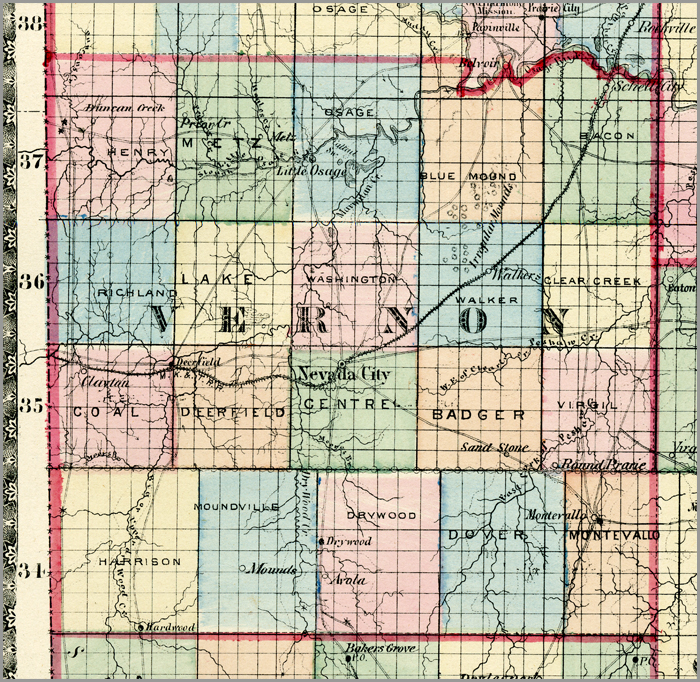Vernon County, Missouri

- Formed: February 27, 1855
- County Population 1860: 4,707
- Slave Population 1860: 140
- Civil War Engagements
– Burning of Montevallo, April 4, 1862
Image courtesy of Wilson’s Creek National Battlefield
The first known non-Native American to enter Vernon County area was Monsieur Du Tissenet, a French-Canadian explorer who passed through in 1714. At the time of first European exploration, the Osage were the only inhabitants of the Vernon County area. By 1826, the Osage were pushed onto reservations in Kansas. The first European settlers arrived in 1829. Three brothers, Jesse J. Summers, Moses Summers, and Allen Summers and their families settled in Vernon County from Wayne County, Tennessee. Other early settlers included: William Modrell in 1832, Cecil D. Ball in 1837, James Fergus in 1837, John K. Gammons, Smith Profitt, and Peter Duncan in 1839. George Douglas, who settled in the area in 1834, came from the Harmony Mission, a missionary group to the Osage based in Bates County. Douglas established a slave plantation in Vernon County.
Vernon County is located on the Missouri-Kansas border. It contains part of the Marais de Cygnes River, Little Osage River, Clear Creek, Kitten Creek, Lost Creek, Coal Creek, Duncan Creek, Fly Creek, Gut Creek, Moon Lake, Hackberry Creek, Horseshoe Lake, and Mulberry Creek. The soil permitted settlers to grow limited amounts of wheat and corn, and grazing for cattle and hogs is abundant.
In Kansas, the Osage Indians experienced difficulties finding wildlife for hunting, and their promised annuities never arrived. They were forced to reenter Vernon County and other Missouri counties bordering Kansas in order to hunt and eat. During the “Indian Fight” of 1838, the Osage stole and slaughtered much of Vernon County residents’ livestock out of hunger and anger. No settlers were hurt or threatened. However, a band of settlers followed the Osage, which led to a fight where several members of both sides were killed. During the 1840s, additional settlers came from other parts of Missouri, Kentucky, and Tennessee. In 1842, the United States military established a post at Fort Scott in the Kansas Territory to manage the pioneer movements into the area and Native American movements west. Several Vernon County men left for California in the early 1850s in search of gold. They were unsuccessful.
Vernon County was officially established on February 27, 1855. It was named after state representative Colonel Miles Vernon, a man from Laclede County who helped pass the act that formed the county. A group of men from surrounding counties were charged with naming and locating the county seat. These men were: Hiram Stevens of Cass County, James Ramey of Bates County, and James F. Walker of Jasper County. They named the county seat at Nevada. Several townships were also established. These were: Center, Drywood, Deerfield, Harrison, Summers, Clear Creek, Osage, and Montevallo.
Vernon County residents were intensely involved in the debate over Kansas’ slave or free status upon entering the Union in the late 1850s. They never conducted violent raids, but they did cross the border to vote for Kansas state constitutions that would allow it to enter the union as a slave state. Several raids occurred in Vernon County, the most prominent of which is the John Brown Raid of 1858. John Brown was a radical abolitionist who led a group of men who had similar beliefs as he and did all they could to help end the continued practice of slavery in Kansas. On the evening of December 20, 1858, two dozen men from John Brown’s Kansas headquarters raided the home of three Vernon County residents. When they returned to Kansas they left one Missouri pioneer lying dead in his nightshirt – and they carried with them 11 slaves, thousands of dollars worth of stolen livestock, wagons loaded with farm equipment, food, clothing, bedding and cash. A grand jury indicted John Brown and his men for larceny and murder. But the lack of legal cooperation meant many Northern officials refused to serve slave state warrants.
When the Civil War began, most residents favored secession. Because the majority of residents favored the South, abolitionists were not allowed to vote for Lincoln in the election. Vernon County men fought in a battalion under Colonel R.A. Brighton in the Battle of Carthage in Jasper County and the Battle of Wilson’s Creek in Greene County. Guerrilla warfare, involving Bushwhackers from Missouri and Jayhawkers from Kansas, was a constant threat back and forth across the Missouri-Kansas border. Many Vernon County residents were themselves Bushwhackers, including the town sheriff, Henry Taylor.
Destruction from the war was widespread. On April 14, 1862, a detachment of the 1st Iowa Cavalry clashed with men from Captain Henry Taylor’s company of Confederate bushwhackers in Montevallo. Captain Taylor had been captured a few days earlier and the Iowans, led by Lieutenant Colonel Charles E. Moss, hoped to prevent the Rebels from joining a stronger force gathering under Colonel John T. Coffee at Cowskin Prairie. Moss’ men were attacked in town on April 14 and after a sharp skirmish, the Union troops burned several buildings the Confederates had used as cover during the fighting. On May 26, 1863, Union troops burned Nevada to the ground in the hopes of diminishing the bushwhackers’ resources. All businesses ceased operation and any remaining citizens had to purchase all of their goods from Fort Scott, a federal military post in Kansas. After the war’s end, guerrilla action continued for a few years. For the most part, however, Confederate and Union men were able to collaborate to rebuild Vernon County. The railroad began construction in the county in the 1870s, which aided reconstruction.
 Browse all collections in Vernon County
Browse all collections in Vernon County
- Consulted:
- History of Vernon County, Missouri (Clinton, MO: The Printery, 1974).
- Nevada and Vernon County’s Heritage,1855-2005: “Pass it On.” Vol. 1. (Nevada, MO: Sesquicentennial History Book Committee, 2005).
- http://www.nevadamo.org/
- http://www.epa.gov/region07/water/pdf/clear_creek_final_111506.pdf
- http://whmc.umsystem.edu/exhibits/ramsay/ramsay_vernon.html
- http://www.kansashumanities.org/Podcasts/Podcast%20Transcipts%20(pdfs)/Vernon%20County%20Final.pdf












